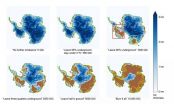Study links marijuana use to poor blood sugar control in middle age
2015-09-14
(Press-News.org) New research published in Diabetologia (the journal of the European Association for the Study of Diabetes) shows that current and former users of marijuana are more likely to have prediabetes--the state of poor blood sugar control that can progress to type 2 diabetes--than never users of marijuana. However the researchers, led by Mike Bancks (University of Minnesota School of Public Health, Minneapolis, MN, USA) failed to establish a direct link between marijuana use and type 2 diabetes.
Marijuana is the most frequently used illicit drug in America (and is estimated to be so globally), with an estimated 18.9 million people aged 12 or older in the USA identifying as current users in 2012. The prevalence of marijuana use for these individuals has increased since 2002. This trend can be expected to continue as states across the USA enact policies to permit medicinal or recreational use. Despite the growing movement to legalise marijuana, little is known about its effect on metabolic health. Previous studies on this subject have revealed conflicting results, with some suggesting marijuana can reduce the risk of diabetes, despite others showing that the drug is associated with an increased calorie consumption.
In this new study, the authors investigated the association between self-reported marijuana use and concurrent and incident prediabetes and full blown type 2 diabetes, considering both quantity used and status of current use. They also aimed to examine the role of body mass index (BMI) and waist circumference as potential confounding and/or mediating factors to these associations. Lastly, given the varying diabetes risk profiles by race and gender, they looked at the effects of sex and race on the associations.
Data from the community-based Coronary Artery Risk Development in Young Adults (CARDIA) study were used to determine marijuana use and presence of prediabetes and diabetes. Individuals in the CARDIA study were 18-30 years of age at study recruitment in 1985-1986 and are currently in their 30th year of observation. The association between marijuana use and prevalence of prediabetes and diabetes was examined in 3,034 participants at CARDIA exam Year 25 (2010-2011) and incidence of prediabetes and diabetes according to previous marijuana use was assessed in 3,151 individuals free from prediabetes and diabetes at Year 7 (1992-1993) who returned for at least one of the four subsequent follow-up examinations over the next 18 years.
The percentage of individuals who self-reported current use of marijuana declined over follow-up, from 28% in 1985-1986 to 12% in 2010-2011. After adjustment for behavioural/lifestyle and physiological characteristics, there was a 65% increased odds of currently having prediabetes in individuals who reported current use of marijuana, and a 49% increased odds of currently having prediabetes in individuals who reported lifetime use of 100 times or more, in both cases compared to individuals who reported never using marijuana. However, there was no association between marijuana use and full blown type 2 diabetes at CARDIA exam Year 25. In the case of these results, the researchers did not distinguish which came first, marijuana use or prediabetes, and it was not possible to take into account if individuals choose to alter their marijuana use because of concern for their health status.
The authors then did further analyses where marijuana use was assessed prior to the development or not of prediabetes. Over 18 years follow-up, a 40% greater risk for developing prediabetes (but not diabetes) was found for individuals who reported lifetime use of 100 times or more compared to individuals who reported never using marijuana. BMI and waist circumference did not affect the associations.
"It is unclear how marijuana use could place an individual at increased risk for prediabetes yet not diabetes," say the authors. But they suggest that it could be because individuals excluded from the study (due to missing information on important factors) generally had higher levels of marijuana use and greater potential for development of diabetes, or that marijuana may have a greater effect on blood sugar control in the prediabetic range than for full blown type 2 diabetes, when other traditional diabetes risk factor levels are exceedingly less favourable.
The authors conclude: "In conclusion, marijuana use, by status or lifetime frequency, was not associated with incidence or presence of diabetes after adjustment for potential confounding factors. However, marijuana use was associated with the development and prevalence of prediabetes after adjustment. Specifically, occurrence of prediabetes in middle adulthood was significantly elevated for individuals who reported using marijuana in excess of 100 times by young adulthood. These results contrast with those previously reported on marijuana use and metabolic health. Future studies should look to objectively measure mode and quantity of marijuana use in relation to prospective metabolic health."
INFORMATION:
ELSE PRESS RELEASES FROM THIS DATE:
2015-09-13
Bremerhaven (Germany), 14th September 2015. This Saturday at a conference in Quebec, Canada an international research team will present the first online data portal on global permafrost. In the Global Terrestrial Network for Permafrost researchers first collect all the existing permafrost temperature and active thickness layer data from Arctic, Antarctic and mountain permafrost regions and then make it freely available for download. This new portal can serve as an early warning system for researchers and decision-makers around the globe. A detailed description of the data ...
2015-09-12
Though national data suggest that women researchers are less likely to obtain independent research funding than men, a study published in the Journal of Women's Health found that male and female researchers at the Johns Hopkins University School of Medicine are funded at nearly the same rate.
Rita Rastogi Kalyani, M.D., M.H.S.; Hsin-Chieh Yeh, Ph.D.; Jeanne Clarke, M.D., M.P.H.; Myron Weisfeldt, M.D.; Terry Choi; and Susan McDonald, M.D., all of Johns Hopkins, authored the study.
Kalyani points out that, in recent years, Johns Hopkins has demonstrated a commitment to ...
2015-09-11
WASHINGTON (Sept. 11, 2015) -- The largest nationwide clinical trial to study high-dose resveratrol long-term in people with mild to moderate Alzheimer's disease found that a biomarker that declines when the disease progresses was stabilized in people who took the purified form of resveratrol.
Resveratrol is a naturally occurring compound found in foods such as red grapes, raspberries, dark chocolate and some red wines.
The results, published online today in Neurology, "are very interesting," says the study's principal investigator, R. Scott Turner, MD, PhD, director ...
2015-09-11
CORAL GABLES, Fla. (September 11, 2015) -- Researchers from the University of Miami and Harvard University address the challenges of effective universal health coverage in low- and middle-income countries, focusing on solving one of the most pressing issues: the care of chronic illnesses. Their suggestions, aimed at strengthening health care systems, include recommendations based on a "diagonal approach" for managing health care. Their report is published in the September issue of the journal Health Affairs.
The authors shared their findings on Wednesday, September 9, ...
2015-09-11
Washington, DC--New work from an international team including Carnegie's Ken Caldeira demonstrates that the planet's remaining fossil fuel resources would be sufficient to melt nearly all of Antarctica if burned, leading to a 50- or 60-meter (160 to 200 foot) rise in sea level. Because so many major cities are at or near sea level, this would put many highly populated areas where more than a billion people live under water, including New York City and Washington, DC. It is published in Science Advances.
"Our findings show that if we do not want to melt Antarctica, we ...
2015-09-11
Burning all of the world's available fossil-fuel resources would result in the complete melting of the Antarctic ice sheet, a new study to be published in Science Advances shows. The Antarctic ice masses store water equivalent to more than 50 meters of sea-level rise. The new calculations show that Antarctica's long-term contribution to sea-level rise could likely be restricted to a few meters that could still be manageable, if global warming did not exceed 2 degrees. Crossing this threshold, however, would in the long run destabilize both West and East Antarctica - causing ...
2015-09-11
A study conducted by biologists at UC San Diego has found that the Africanized honey bee--an aggressive hybrid of the European honey bee--is continuing to expand its range northward since its introduction into Southern California in 1994.
The study, published in this week's edition of the journal PLOS ONE, found that more than 60 percent of the foraging honey bees in San Diego County are Africanized and that Africanized bees can now be found as far north as California's delta region.
"Our study shows that the large majority of bees one encounters in San Diego County are ...
2015-09-11
Scientists have identified an ingeniously elegant brain circuit consisting of just five nerve cells that allows female crickets to automatically identify the chirps of males from the same species through the rhythmic pulses hidden within the mating call.
The circuit uses a time delay mechanism to match the gaps between pulses in a species-specific chirp - gaps of just few milliseconds. The circuit delays a pulse by the exact between-pulse gap, so that, if it coincides with the next pulse coming in, the same species signal is confirmed.
It's one of the first times ...
2015-09-11
Researchers from Lund University in Sweden have shown that well-developed eyes come at a surprising cost to other organ systems. The study involving Mexican cavefish shows that the visual system can require between 5% and 15% of an animal's total energy budget.
Researchers have long associated the presence of a well-developed brain with major energy consumption. This means that animals that develop advanced nervous systems require environments where this is possible. There has to be good access to nutrients, and every investment in an organ comes at a cost to some other ...
2015-09-11
WASHINGTON (Sept. 11, 2015) - A statement from American College of Cardiology President Kim Allan Williams Sr., M.D., FACC, regarding the National Institutes of Health stopping the SPRINT trial early after demonstrating the positive benefits of lower blood pressure control targets:
"About 70 million American adults have high blood pressure and only half of them have their condition under control. The preliminary data demonstrates why the cardiovascular community must continue to aggressively fight a condition that leads to stroke, kidney disease and heart problems for ...
LAST 30 PRESS RELEASES:
[Press-News.org] Study links marijuana use to poor blood sugar control in middle age

